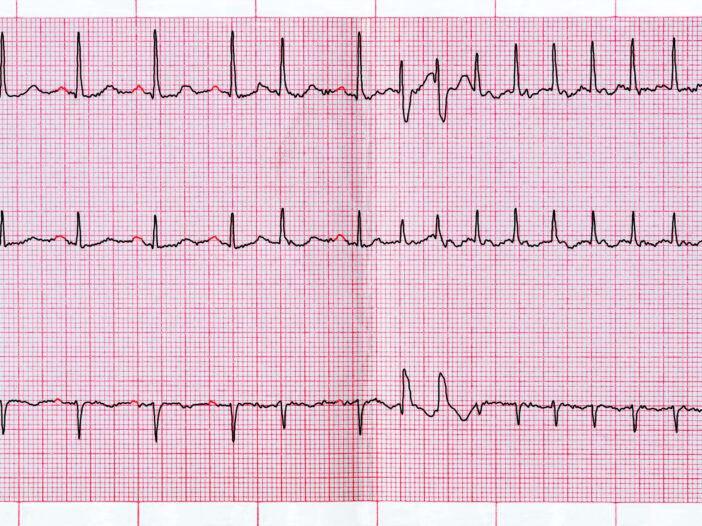
A healthy heart beats smoothly, with a steady rhythm. If your heart beats too quickly, too slowly or irregularly, you may be experiencing arrhythmia. In that case, it’s important to be diagnosed and treated to reduce your chances of more serious problems such as stroke. In fact, your risk of stroke is about five times higher if you have atrial fibrillation (AFib), the most common form of arrhythmia.
Trust the board-certified cardiologists at CMHVI to provide you with the arrhythmia care you need. Our cardiac electrophysiology heart specialist will use the resources available in our Electrophysiology Lab to diagnose and treat any condition affecting your heart’s electrical system. We offer a range of treatments that can help you feel better and help prevent the health problems that can result from this condition.
When Your Beat is Off: About Arrhythmia
Arrhythmias affect millions of Americans, including about nine percent of people over the age of 65. They are related to the complex system in your heart that manages your heartbeat. Certain cells in your heart create electrical signals that cause your heart to beat and pump blood. When you have AFib or other type of arrhythmia, the electrical impulses that control your heartbeats occur unevenly, rather than at a steady, measured pace. People with AFib sometimes describe it as making their heart feel as if it’s quivering like a bowl of gelatin.
In addition to AFib, there are several kinds of arrhythmias, including:
- Bradycardia (slow heart rate)
- Tachycardia (very fast heart rate)
- Conduction disorders (abnormal heartbeat)
- Premature contraction (early heartbeat)
It’s important to diagnose and treat AFib and other heart rhythm disorders as early as possible, because they can interfere with normal blood flow. Over time, this can damage your lungs, brain and other organs. They may even lead to stroke or heart failure.
Know the Symptoms of Arrhythmia
If you experience any of the following symptoms, you may have AFib or some other heart rhythm abnormality.
- A fast, slow or irregular heartbeat
- A feeling that your heart is skipping beats
- Lightheadedness or dizziness
- Chest pain
- Shortness of breath
- Sweating
- Getting tired more easily when you exercise
- Fainting
- Chronic fatigue
How Will You Be Diagnosed?
When you visit our state-of-the-art Electrophysiology Lab, our cardiac electrophysiology heart specialists will take your medical history and perform a physical exam. They’ll also perform one or more of the following diagnostic tests to learn more about your heartbeat.
- Electrocardiogram (ECG): This test uses small sensors (electrodes) attached to your chest and arms to record electrical signals as they travel through your heart.
- Echocardiogram: In this noninvasive test, sound waves are used to produce a video image of your heart in motion.
- Holter monitor: This portable ECG device is carried in your pocket or worn on a belt or shoulder strap. It records your heart’s rhythms for 24 hours or longer, giving your provider a prolonged look at any problems.
- Transtelephonic monitor: For infrequent arrhythmias or arrhythmias that come and go, this monitor attaches to your arms, wrists or fingers for a month or two. It records and stores information about your heart’s electrical system, which can be transmitted to your provider.
- Treadmill testing: Also known as a stress test or exercise test, a treadmill test can check for arrhythmias that occur with activity.
- Blood tests: These help your provider rule out thyroid problems or other substances in your blood that may lead to AFib.
- Chest X-ray: These images help your provider see the condition of your lungs and heart and may help diagnose conditions other than AFib that may explain your signs and symptoms.
Understand Your Treatment Options
If our tests show that you have AFib or another form of arrhythmia, you and your provider discuss the best approach to managing your symptoms and reducing your risk of complications. Your provider may recommend one or more of the following treatments for arrhythmia:
- Medication: Drugs used to treat arrhythmias include anti-arrhythmia drugs, drugs that control heart rate and blood thinners.
- Pacemaker and Implantable Cardioverter-Defibrillator (ICD): An ICD is a tiny device implanted through a small incision under the collarbone during a minimally invasive surgery. The system includes a palm-sized device with electrical leads that connects to your heart to restore a normal rhythm. Recovery is quick, though some patients may stay overnight.
- Cardioversion: Cardioversion is a medical procedure for treating an abnormally fast or irregular heartbeat. Most commonly used for AFib, atrial flutter or ventricular tachycardia, cardioversion sends an electrical impulse to your heart muscle, restoring normal heart rhythm. Cardioversion is usually performed as a scheduled treatment and may be repeated if the arrhythmia returns.
- Radiofrequency Ablation: During an ablation procedure, small areas of your heart muscle are purposely destroyed to create scars (called lesions) that improve your heart’s function by correcting a faulty electrical process.
- Catheter Ablation: This procedure uses intense cold or high-frequency electrical energy to disrupt an abnormal heart rhythm. Ablation is performed surgically or with a thin, flexible tube (catheter) that is inserted into a blood vessel in the groin or neck and guided into the heart. Your provider uses the catheter for the ablation, which is done either with intense cold (cryo-ablation) or with high-frequency energy (radio-frequency ablation). Some patients require a pacemaker after an ablation is performed.
- This procedure can be done with cryo-ablation, radio-frequency ablation, microwave ablation, ultrasound energy or laser energy. There are two types of surgical ablation, minimally invasive via small chest incisions or during open-heart surgery.
